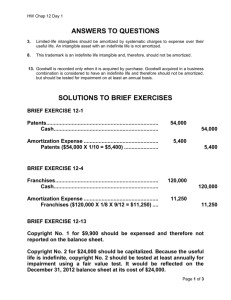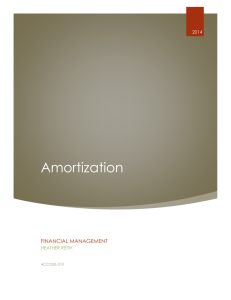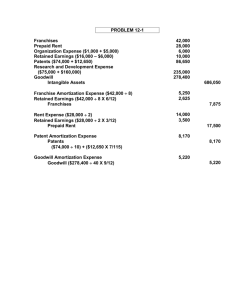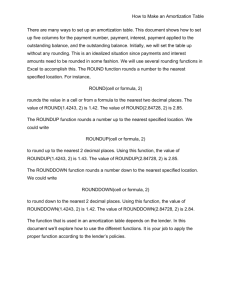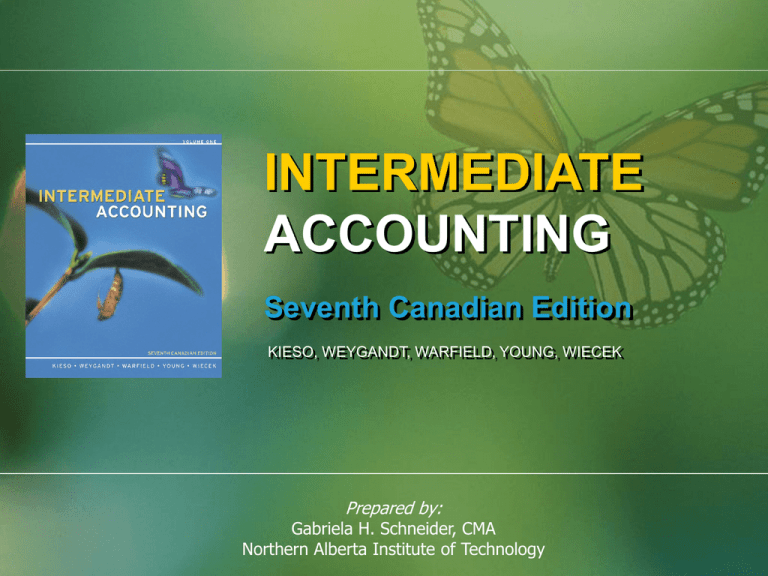
INTERMEDIATE
ACCOUNTING
Seventh Canadian Edition
KIESO, WEYGANDT, WARFIELD, YOUNG, WIECEK
Prepared by:
Gabriela H. Schneider, CMA
Northern Alberta Institute of Technology
CHAPTER
12
Amortization, Impairment, and
Disposition
Learning Objectives
1. Explain the concept of amortization.
2. Identify and describe the factors that must be
considered when determining amortization
charges.
3. Determine amortization charges using the
activity, straight-line, and decreasing charge
methods and compare the methods.
4. Explain the accounting procedures for
depletion of natural resources.
Learning Objectives
5. Explain special amortization methods.
6. Identify and understand reasons why
amortization methods are selected.
7. Explain the accounting procedures for a
change in the amortization rate.
8. Explain the accounting issues related to
asset impairment.
Learning Objectives
9. Explain the accounting standards for longlived assets to be disposed of.
10.Describe the accounting treatment for the
disposal of property, plant and equipment.
11.Explain how property, plant and equipment
are reported and analysed.
Amortization, Impairment and
Disposition
Amortization
Factors
involved
Methods of
cost allocation
Depletion
Special
methods
Selecting an
amortization
method
Other
amortization
issues
Impairments
Recognizing
impairments
Measuring
impairments
Subsequent
measurement
Disposition
Property, plant,
and equipment to
be disposed of
Sales of property,
plant and
equipment
Involuntary
conversion
Other issues
Presentation
and Analysis
Presentation
and disclosure
Perspectives
Appendix 12A
Amortization
and Income
Tax
Capital cost
allowance
method
Amortization – Concept
• Amortization is a means of cost allocation
• It is not a method of valuation
• Amortization involves:
– Allocating the cost of capital assets to expense
(matching principle) in a systematic and rational
manner to periods expected to benefit from use
of assets
• The terms amortization and depreciation are
used interchangeably
Factors in the Amortization
Process
Questions to be answered:
1. What amount of the asset’s cost is to be
amortized?
2. What is the asset’s useful life?
3. What pattern and method of cost
apportionment is best for this asset?
Which amortization method best matches the
way this asset is used/consumed?
Amount to Be Amortized
• Amortizable amount is the amount to be
amortized
• It is determined as:
– Original cost of the asset less
– Estimated residual (salvage or disposal)
value
Useful Life of an Asset
• An asset’s useful life and physical life are not
the same (expressed in time or units)
• Useful life is sometimes referred to as the
economic life—the period of time over which
the asset will produce revenue for the
company
Useful Life of an Asset
• Assets are retired (from productive life) due to:
– physical factors (such as casualty)
– economic factors (such as obsolescence)
• Economic factors in turn include:
– inadequacy (asset cannot meet current
demand)
– supercession (by a better asset)
– obsolescence (other factors)
Amortization Methods: Overview
Amortization
Methods
Financial Accounting
Amortization Methods
Activity
method
Tax
Amortization
Increasing
Straight-line Decreasing
Charge
charge
method
Methods
methods
1. Declining-balance
2. Sum-of-the-years’-digits
(not widely used in Canada)
Special
methods
1. Group and Composite
2. Hybrid methods
Amortization Methods: Example
Crane Ltd. buys a crane at the beginning of the current
fiscal year. Information relating to the crane follows:
•
•
•
•
Cost: $500,000
Estimated useful life: five years (or 30,000 hours)
Residual value end of five years of use: $50,000
Actual hours used during the current year: 4,000 hours
and assume 4,700 in next year
Based on this information, calculate the amortization for
the current year using: activity, straight-line, and
decreasing charge methods
Activity Method (unit = hour)
This same
1. Depreciable base = $500,000
– $50,000 = $450,000
rate is used
each year
2. Amortization per hour = $450,000 / 30,000 = $15.00
3. Amortization (current) = $15.00 X 4,000 hours = $60,000
Amortization (next) = $15.00 X 4,700 hours = $70,500
4. Amortization Schedule:
Book Amortization
Year
Value
Expense
1 $500,000 $60,000
2 $440,000 $70,500
Accumulated
Amortization
$ 60,000
$130,500
Book value
End of year
$440,000
$369,500
Straight-Line Method
1. Depreciable base = $500,000 – $50,000 = $450,000
Note that
2. Annual Amortization = $450,000
/ 5the
years = $90,000
amortization
expense is
3. Amortization Schedule: the same
each year
Book Amortization Accumulated
Book value
Year Value
Expense Amortization End of year
1 $500,000 $90,000
$ 90,000
$410,000
2 $410,000 $90,000
$180,000
$320,000
Decreasing Charge Method:
Declining-Balance Method
1. Rate of Amortization = 2 x (1/5) = 40%
2. Amortization (current) = $500,000 x 0.40 = $ 200,000
Rate= (100%
Amortization
(next)
= ($500,000 - $200,000) x 0.40
Useful Life) x 2
= $120,000
3. Amortization Schedule:
Book Amortization Accumulated Book value
Last year is End of year
Year Value
Expense Amortization
rounded. Book $300,000
1 $500,000 $200,000
$200,000
value cannot be$180,000
2 $300,000 $120,000
$320,000
less than residual
3 $180,000 $ 72,000
$392,000
$108,000
value.
4 $108,000 $ 43,200
$435,200
$ 64,800
5 $ 64,800 $ 14,800
$450,000
$ 50,000
Comparison of Methods
Activity Method
Straight-Line Method
• Best matches revenues
and expenses
• Only appropriate where
usage not a function of
time
• Difficult to estimate total
number of units over life
of asset
• Simple to use
• Based on two broad
assumptions
– Constant usage
– Other costs same each
year
• Does not match always
revenues and expenses
Decreasing Charge Method
• Best match of some assets’ productivity to cost
• Less variable total asset expense over asset life
Depletion: Terminology
• Depletion refers to the cost basis write off of
natural resources
• Natural resources are characterized by:
– complete removal of the asset
– replacement of the asset only by an act of
nature
Determining the Depletion Base:
Factors
What they Are
Types of Costs
•
Acquisition cost
•
•
Exploration costs
•
•
Development costs
(Tangible costs): not part
of depletion base
•
•
•
Development costs
(Intangible costs)
• Restoration costs
•
Price paid to search for
and find deposit of the
natural resource
Costs incurred to find the
natural resource
Costs of heavy equipment
for extracting and shipping
natural resources
Drilling costs, tunnels, and
shafts
To restore after extraction
Depletion of Resource Cost
• Depletion calculated using an activity
approach (units of production)
• Depletion charge initially debited to Inventory
• Inventory credited when the resource is sold
– Follows matching principle
– Becomes Cost of Goods Sold
• Where useful life is clearly linked to the
resource, tangible assets are amortized using
units of production method
Depletion of Resource Cost
Mining Company has right to use land to mine gold:
Lease Cost:
$
50,000
Exploration Cost:
$ 100,000
Development Cost:
$ 850,000
Total Capitalized Cost:
$1,000,000
Estimated Production (Useful Life) = 100,000
ounces of gold
Depletion of Resource Cost
Depletion Rate = Total Costs – Residual value
Total estimated units
Depletion Rate = 1,000,000 – 0 = $10 per ounce
100,000
Entry to record 25,000 ounces mined:
Inventory
250,000
Accumulated depletion
250,000
Group and Composite
Amortization Methods
• The group method is applied to a collection of
assets similar in nature
• The composite method is applied to a collection
of assets dissimilar in nature
• The composite amortization rate is determined as
follows:
Total of Annual Amortization for All Assets
Total Cost of All Assets
Composite Amortization Method:
Example
Given the following information relating to Cars, Trucks,
and Campers:
Asset
Cars
Trucks
Campers
Cost
$145,000
Amortizable
Cost
Annual
Amortization
$120,000
$ 40,000
44,000
40,000
10,000
5,000
30,000
$ 6,000
$224,000
$190,000
$56,000
Composite amortization rate is:
$ 56,000 = 25%
$224,000
Group and Composite
Amortization Methods
• When an asset is sold, or otherwise disposed
of, under group/composite amortization:
– no gain or loss on disposal is recorded
– the difference between cost and sale proceeds
is debited to Accumulated Amortization
Selecting an Amortization Method
•
Three main factors or motivations for
method of selection:
1. Matching
2. Simplicity
3. Perceived economic consequences
•
Where possible, matching is the best
motivation for method selection
Partial Year Amortization
•
•
When an asset is bought sometime during
the year, a partial amortization charge is
required
The procedure is:
1. determine amortization for a full year, and
2. allocate the amount between the two periods
affected (See upcoming example)
Amortization and Partial Periods
Units of Production/Use Method
• No special calculations required
• Calculate the usage rate and apply to actual for
the period
• Same rate used in subsequent years
Straight-Line Method
• Calculate the amortization for the portion of the
year
• Generally use the nearest full month
Declining-Balance Method
• More complex calculations involved
Partial Year Amortization:
Example
• Asset purchased on July 1, 2004. Information
relating to the asset is:
• Cost: $10,000
• Estimated service life: five years
• Residual value end of five years: None
• Determine amortization expense under the
declining balance method
Determine full year amortization as follows:
First full year (2004) = $10,000 x 40% = $4,000
Second full year = $6,000 x 40% = $2,400
Third full year = $3,600 x 40% = $1,440
Partial Year Amortization:
Example
Double-declining: date of purchase, July 1, 2004
Allocate first full year’s
amortization of $4,000
between 2004 and 2005
$2,000
2004
Allocate second full year’s
amortization of $2,400
between 2005 and 2006
$2,000 $1,200
$1,200
2005
2006
Revision of Amortization
Estimates
•
•
•
•
•
Determination of amortization involves initial
estimates (life, residual value)
When these estimates are revised,
amortization is recalculated
These revised amortization expenses apply
prospectively to the remaining life of asset
The changes do not affect prior periods
CICA Handbook, Section 1506
Revision of Amortization
Estimates: Example
• Depreciable asset purchased for $90,000
– Estimated life was 20 years
– Estimated residual value: None
• In Year 11, estimates were revised as follows:
– Estimated life : Total of 30 years
• Determine amortization for 11th year based on
the straight-line method of amortization
Revision of Amortization
Estimates: Example
• Accumulated Amortization to date of revision
of estimates:
– ($90,000 – $0) / 20 years = $4,500 per year
– $4,500 x 10 years = $45,000 Accumulated
Amortization
– Book Value: $90,000 – $45,000 = $45,000
• Amount to be amortized (11th to 30th year = 20
years)
– ($45,000 – $0) / 20 years = $2,250 each year
Impairments
• An impairment occurs when:
– the carrying amount of an asset is not
recoverable, and
– a write-off of the impaired amount is needed
• To determine the amount of impairment, a
recoverability test is used
Impairments:
The Recoverability Test
Impairment?
Sum of expected
future net cash flows
from use and disposal
of asset is less than
the carrying amount
Impairment has occurred
Sum of expected
future net cash flows
from use and disposal
of asset is equal to or
more than the
carrying amount
No impairment
Impairments:
The Recoverability Test
Impairment has occurred
Determine
impairment loss
Loss equals difference between
carrying amount and fair value of
asset based on a method that
discounts the future flows to their
present value
Impairment: Accounting
Impairment has occurred
Assets held for use or
to be disposed of
other than by sale
1. Loss equals carrying
value less fair value
2. Amortize new cost basis
3. Restoration of impairment
loss is not permitted
Assets are held
for sale
1. Loss equals carrying value
less fair value less
cost of disposal
2. No amortization is taken
3. Restoration of impairment
loss is permitted
Dispositions of PP&E
• Plant assets may be:
– retired voluntarily, or
– disposed of by sale, exchange, involuntary
conversion
• Depreciation is recorded up to the date of
disposal before determining gain or loss
• Gains or losses from involuntary conversion
are often reported as extraordinary items
Long-Lived Assets to be
Disposed of
By Sale
Classify As
Balance
Sheet
Classification
Measurement
Held for sale
Separate
classification
of long-term
assets
At lower of carrying
amount and NRV
Other than by Sale
Held and used
Property, Plant,
& Equipment
Test for impairment
under CICA Handbook
Section 3063
Analysis of Property, Plant, and
Equipment
Asset Utilization:
Total Asset Turnover =
Net Revenue
Average Total Assets
Cost Control:
Profit Margin =
Net Income
Net Revenue
Analysis of Property, Plant, and
Equipment
Profitability or Return on Assets:
= Asset Turnover x
Profit Margin
= Net Revenue
x
Average Total Assets
Net Income
Net Revenue
COPYRIGHT
Copyright © 2005 John Wiley & Sons Canada, Ltd.
All rights reserved. Reproduction or translation of
this work beyond that permitted by Access Copyright
(The Canadian Copyright Licensing Agency) is
unlawful. Requests for further information should be
addressed to the Permissions Department, John
Wiley & Sons Canada, Ltd. The purchaser may make
back-up copies for his or her own use only and not
for distribution or resale. The author and the
publisher assume no responsibility for errors,
omissions, or damages caused by the use of these
programs or from the use of the information
contained herein.

